Review of Little but Fierce, a complete D&D 5e rewrite for kids!
Note: This post may contain affiliate links. At no additional cost to you, I may earn a small commission from purchases made using them. TTRPGkids uses this to keep the site going. Read full disclosure here.
Check out the newly released Mara expansion for Little But Fierce too!
Jump to:
Little but Fierce, taking the D&D age recommendation to 6+
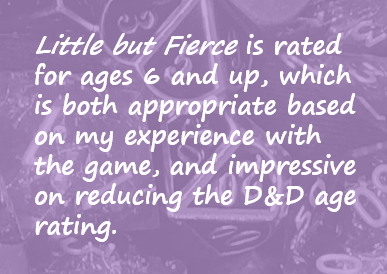
Little but Fierce is rated for ages 6 and up, which is both appropriate based on my experience with the game, and impressive on reducing the D&D age rating.
There is a bit of reading required, but the language is modified to be age-appropriate (i.e. using words that younger kids can understand or can be easily explained), and the mechanics are adjusted to be easier to track. At the very young end, kids might still need a little assistance to create characters and what-not in Little but Fierce, but I think that goes for most of my adult D&D games as well. It’s set up for kids to be able to play without much, if any, intervention, which is great for allowing player autonomy.
Little but Fierce‘s creatures and spells are also adjusted more towards kids, so there’s no bone devils or power word kill. There’s still dragons and mummies and dinosaurs that you can encounter, and there are a ton of spells to pick from that all harken back to the core of what D&D spells do, but they’re rewritten to be understandable to kids and be a bit more age-appropriate for your little ones.
Little but Fierce facilitating D&D settings for kids:
Little but Fierce is a system, so you can make the setting anything you want (and there’s some recommendations for this in the storyteller’s toolkit that comes with the game). However, since it is based on D&D 5e, a lot of the creatures, spells, items, etc are based on the classic fantasy setting. You can use this base or homebrew – the system is outfitable to lots of different scenarios similar to how you’d homebrew a setting for D&D or another tabletop RPG.
Easier characters and character sheets in Little but Fierce:
Little but Fierce has a very clear character creation guide that walks you through the who, what, how, and why of your character. There’s simple to answer backstory and character prompts to help kids come up with ideas, and it has a great step-by-step for either players to make characters themselves or for game leaders to ask questions to help out.
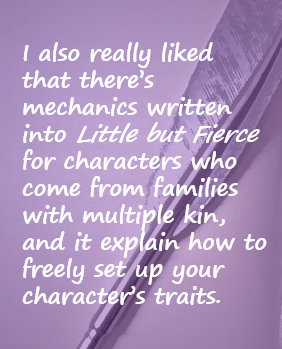
You also choose your character’s kin, with each having unique traits. There’s a whole bunch of rewritten D&D 5e choices ranging from humans to elves to birdfolk to fauns to goblins and more. I also really liked that there’s mechanics written into Little but Fierce for characters who come from families with multiple kin, and it explains how to freely set up your character’s traits.
You also have a choice between four classes in Little but Fierce: druid, fighter, mage, and thief. Each one is a fully rewritten class to make them easier to follow for kids than all the options in D&D 5e while still giving freedom of choice. They have class powers, talents and equipment choices, spell and fighting style options, etc to make character creation unique, so, it is parsed down for access and still allows customizability.
On the character sheet, you have 4 abilities, each with 2-3 skills, so it is much easier to track than the 6 stats and 18 skills in D&D 5e. Stats also all have pictures next to them, so kids who are still learning to read can still use the Little but Fierce character sheet and get some help with recognizing the new words via the associated pictures. If you want a quick character too (or just an example to build from), there’s also pre-made character sheets available for a quick drop in or trial game too!
Little but Fierce‘s parsed down D&D mechanics and key game features:
Smaller but impactful dice rolls:
Just like in D&D, Little but Fierce has you roll to see how well you handle attacks, casting, skill checks, resistances, etc. However, here, that’s all done with a d10 instead of a d20 to make it a bit easier for kids.

You roll your d10 then add any modifiers and that’s your result. A nat 1 is still a critical fail and a nat 10 is a critical success. Everything in the game is adjusted to work with the d10 rolls instead of the d20’s, so Little but Fierce stays very true to the D&D 5e base but tailors more towards a younger kid’s counting and math skills.
I also really liked one of the language rewrites in Little but Fierce where instead of advantage and disadvantage, it is written as good luck or bad luck granted by the game master. I think this is a bit easier for kids to quickly understand, and it kind of ties into the game a bit more where some force is driving luck.
Little but Fierce‘s expert level language rewrites:
The BIG feature of Little but Fierce for me is the level of attention paid to the rewrites. In general, everything is rewritten to a kid’s reading level but then also, it’s tweaked to facilitate positive themes. I’ll break down a few specific areas here, but THE WHOLE GAME is like this – it’s a huge feat by the author, and it really sets this game apart from other D&D 5e modules for kids that I’ve checked out.
Newly described spells
For spells, instead of spell levels, Little but Fierce uses spell grades to make a clear language distinction between character levels and spell levels (the language used in D&D 5e). From there, every spell has been rewritten with accessible language and includes a small reference chart that shows casting time, range, length of affect, and required components. It also has symbols next to the spell for which classes can cast it.
The spell chart is way more intuitive to read than some of the big text blocks in D&D, so it’s a bit easier to use spells quickly. The symbols allow for being able to clearly see if it is something your character can use without having to reference a separate chart.
Little but Fierce‘s rewrites are also very well done – it is a huge task to rewrite every spell and make it more understandable while still maintaining all the complexity that’s in the reference material, but DC Bradshaw pulled it off.
Little but Fierce and re-spinning combat
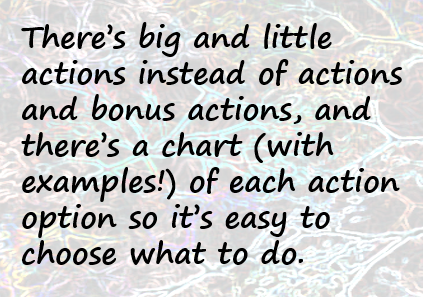
In Little but Fierce‘s section for fighting, this is also tactfully rewritten for kids to help combat run a little more smoothly. There’s big and little actions instead of actions and bonus actions, and there’s a chart (with examples!) of each action option so it’s easy to choose what to do.
I also liked that when a character is knocked out, they make recovery rolls instead of death saving throws. On three fails, your character is badly hurt and maybe can’t continue (depends on the players and GM) instead of the character outright dying like you’d see in unmodified D&D. Instead of your character dying in the middle of a fight, maybe they injured their leg badly and have decided to retire – this is a really clear way to taking a downed character out of the game to reroll for a new one without having a big death scene in a kid’s game.
Reimagined creatures in Little but Fierce
Like with spells, the creatures list in Little but Fierce is also rewritten to tailor more towards a kid’s reading level. There’s very clear stat charts to use as an easy reference versus trying to read through huge blocks of text, and the mechanics are re-tooled for clarity. They are also sorted by danger level to emphasize, again, that this is different from character levels. This would be a great creature list for a new GM to use for their first campaign from start to finish – there’s creatures from danger level 0 to danger level 20 to fill multiple sessions and adventures.
Many magical items made easy!
There is also a great magic items list in Little but Fierce! Each item has a table showing the cost (so no need to calculate based on rarity, bonuses, etc) along with the flavor text and use details. The items are also pretty fun – there’s a flying carpet, a scarf of translation, an impossible anchor, and more. Several items are based on D&D 5e (like the impossible anchor stemming from the immovable rod) and some seem pretty original (like the scarf). I appreciated that there was an items list so you don’t have to worry about having a well stocked magic shop either.
Little but Fierce‘s helpful storyteller toolkit:
Little but Fierce also has a storyteller toolkit that covers a lot of important details that generally happen or need to be considered when running tabletop RPGs with kids.
The toolkit talks about how to run an engaging game by finding common group interests, tweaking the rules, and setting up how everyone expects the game to run. There’s suggestions for playing without fighting or magic depending on the group’s preferences as well.
Little but Fierce‘s toolkit also covers a whole bunch of safety tools including the X-card, lines, traffic lights, and the remote control method. It stresses the special importance of maintaining the players’ trust by not trying to trip them up or throw too big a curve ball at them because… they’re kids!

The storyteller toolkit talks about setting up fun ways to gain XP too – this can be through fights, but it can also be through doing cool things and solving puzzles or traps. There’s tips for setting difficulty and how to set up interesting puzzles and traps as well.
There can be a lot of nuance involved when playing tabletop RPGs with kids, from the extra bits of patience required for handling some extra wild shenanigans from your players to making the setting and story engaging for players that are into WAY different stories and interests than you. The storyteller toolkit that comes with Little but Fierce helps to overcome some of that learning curve and give a heads up on some methods to handle – making a game accessible to kids involves the GM being able to use these tools too.
Overall impression of Little but Fierce:
Little but Fierce is a well-written and thorough tabletop RPG that is true to the heart of D&D 5e but with language and tools specifically aimed at children. The character sheet is intuitive and easy to reference at a quick glance, the writing is not only age-appropriate but age-focused, and there’s attention paid to the GM side as well. For anyone wanting to start D&D with their kids, this is a great game to that kick off and use as a solid introduction to tabletop gaming in general.
Where to find a copy of Little but Fierce:
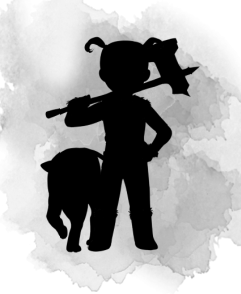
Little but Fierce can be found here on DriveThruRPG! And you can find the Mara expansion, which includes the barbarian subclass here!
Please let me know in the comments if you have any questions, have tried Little but Fierce because of this post, or have played Little but Fierce before!
Make sure to subscribe to the TTRPGkids monthly newsletter to stay up to date on the latest reviews, tips and tricks, game and podcast list updates, and more! Thank you for playing tabletop RPGs with your kids and sharing this awesome hobby with the next generation!
Looking for more D&D material for kids? Check out my list of D&D for kids adventure, hacks, and rewrites here!

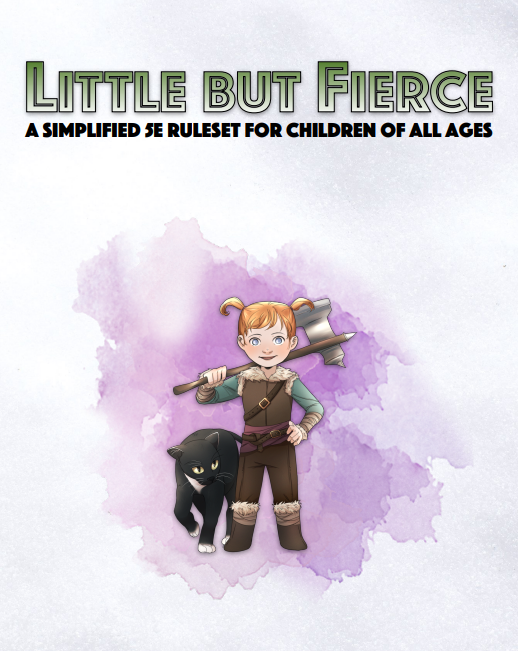
4 thoughts on “Review of Little but Fierce, a complete D&D 5e rewrite for kids!”